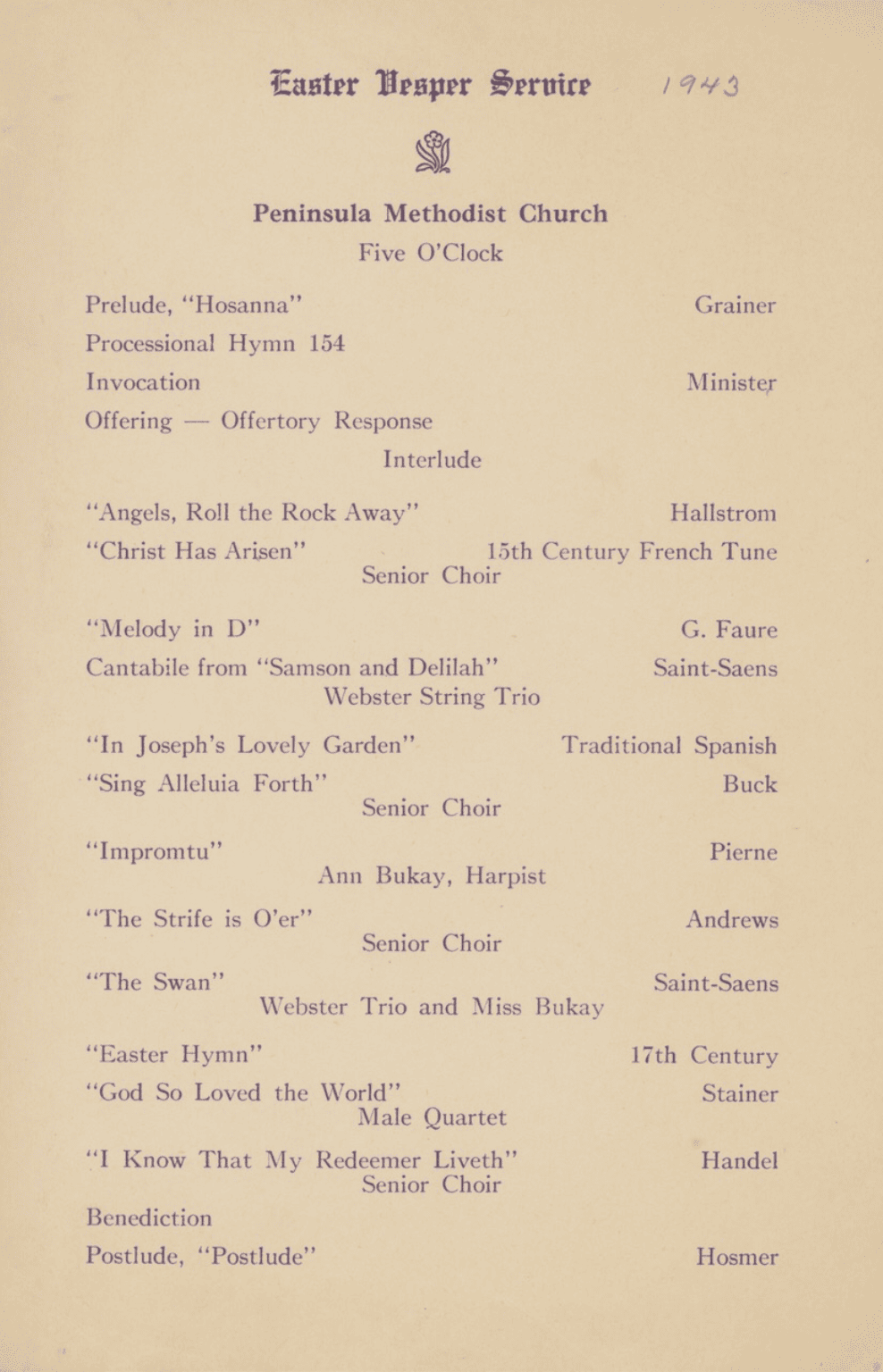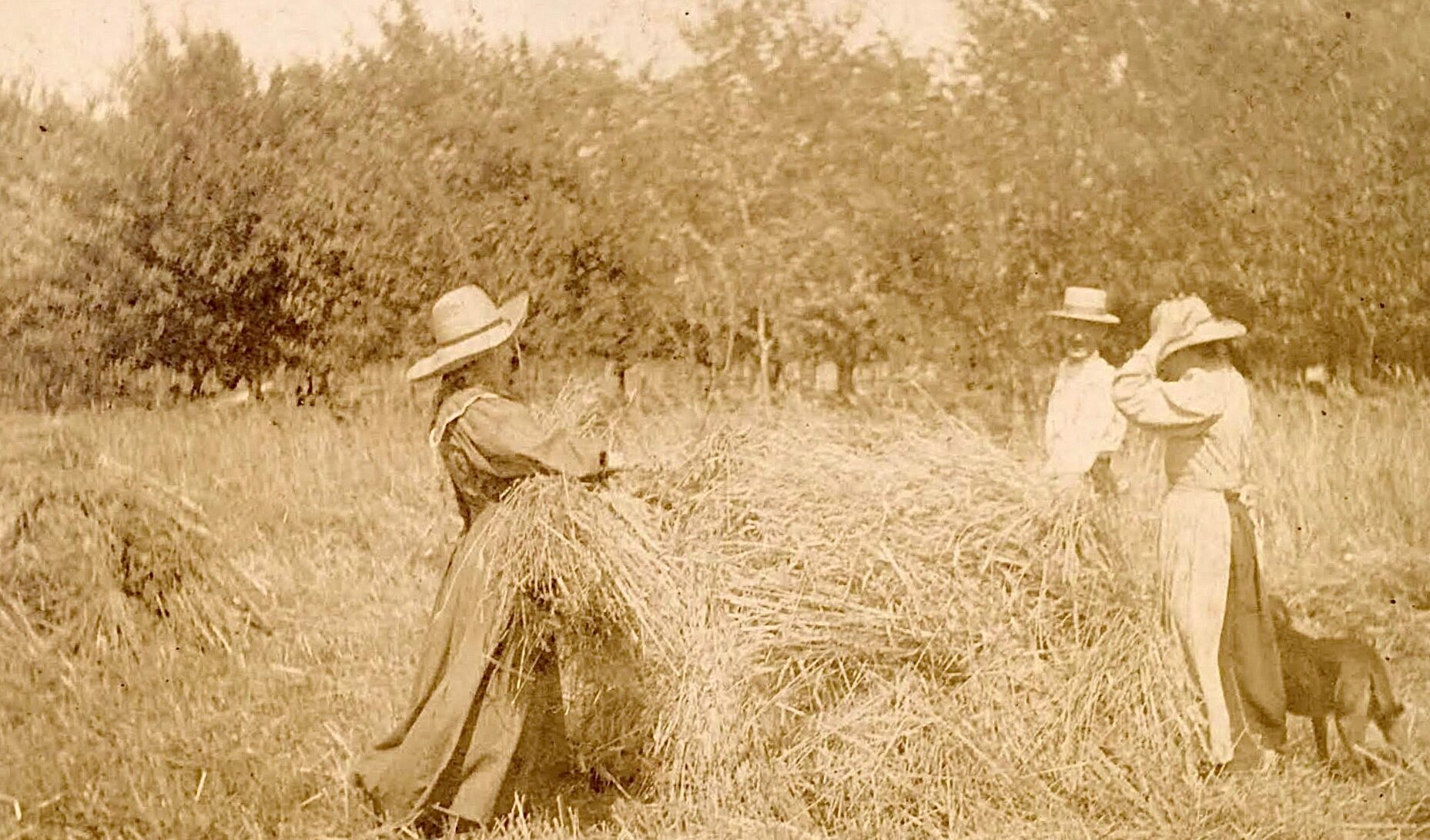This post may contain affiliate links. Probably doesn’t, but it might. It doesn’t cost you anything extra but if you use these links to buy something, we may earn a commission.
Just because you farm does not mean you forsake everything else. I am fortunate to come from a family with a strong artistic streak and a dedication to learning. Music has a long tradition in our family. A great example is The Webster Trio. These three sisters, close in age, played together for over a decade, delighting their church community, and audiences in Wilmington, Philadelphia, and beyond. Two went on to professional music careers and the third remained a devoted member of numerous community groups.
Their grandfather, Harry Rotthouse, learned to play the violin and piano, and played fiddle at square dances and Grange events. That’s how he met his wife. Their great-grandmother, Rachel Talley, had a player piano. Their grandmother, Mabel Rotthouse, made sure her daughter learned to play the piano as well. It was natural for Rachel Rotthouse Webster to make sure her daughters learned about music. Not only did they learn, but they excelled.
Table of Contents
A musical pedigree to The Curtis Institute of Music
To understand the Webster Trio, we must first step back to their formative teachers, Max Aronoff, Jascha Brodsky, Orlando Cole, and Martha Massena.
Why are their instructors even mentioned? For serious musicians, one’s teacher is like a pedigree or family history. So, who were these people? Indulge me with providing a little background.
Mary Louise Curtis Bok, only child of Louisa Knapp and Cyrus Curtis (Curtis Publishing Co.–Saturday Evening Post and Ladies’ Home Journal) established the Curtis Institute of Music in 1924 to train the next generation of musical artists. Curtis remains one of the pre-eminent music conservatories in the world (admission rate less than 2%). Most faculty were and are Philadelphia Orchestra members.
Graduating students Max Aronoff, Jascha Brodsky, Orlando Cole, and Benjamin Sharlip (replaced by Charles Jaffe in 1934) formed the Curtis String Quartet in 1932, having played together as students and graduates for the previous five years. By 1935, they were invited by BBC to London to play for the Jubilee of George V, along with other Philadelphia musicians, including former classmate Martha Halbwachs Massena, pianist. They played pieces by Gian Carlo Menotti (Italian Dance) and former classmate Samuel Barber (Serenade for String Quartet and Dover Beach), composed specifically for their ensemble.
The Quartet had already made a recording for RCA Studios, and proceeded to tour Europe following the Jubilee. The Curtis String Quartet’s success brought another tour of Europe for 1936-37 and yet again for 1937-38. The threat of war kept them home after that, and they toured in the United States and each developed a teaching studio privately as well as teaching at Curtis.
The New School of Music in Philadelphia
In 1942, the Curtis String Quartet left the Curtis Institute and founded the New School of Music, also in Philadelphia, to train chamber and orchestral players, as they disagreed with Curtis Institute’s emphasis on solo work. The New School of Music was for students ready to train professionally. The Quartet re-joined with Curtis in the 1950s, teaching at both the New School and Curtis for the next several decades. The group played together until the death of Max Aronoff in 1981. Martha Massena, a featured piano soloist at George V’s Jubilee, also taught at Curtis and the New School, as well as performing throughout Europe and the United States. The New School eventually became part of Temple University’s College of Music in the 1980s.

About 1934-36, Barbara, Elaine, and Joanne began music lessons with private instructors. Barbara started with Mrs. Franklin in Arden, Elaine with Miss Littleton on Shipley Road, and we do not know Joanne’s first teacher.
1939 is when the Webster girls began studying with “Mr. A, Mr. B, and Mr. C” as they called them. Max Aronoff coached the trio, Barbara studied with Jascha Brodsky, Joanne studied with Orlando Cole, and Elaine studied with Martha Massena. When we understand how renowned these musicians already were, we can appreciate how well the girls individually and as a trio must have played to be accepted as students. These teachers had to consider the Websters extremely talented. It is remarkable that they accepted these girls, ages 10 to 12, as students. As world-class musicians, the Curtis String Quartet members demanded dedication and ability.


The girls did not have the luxury of sound proofed studios at home, and they learned to concentrate as Elaine practiced piano in the parlor, Joanne practiced cello in the dining room, and Barbara practiced violin in the kitchen. At the same time. And then they would practice ensemble pieces together in the parlor. This concentrated practice obviously worked, as each girl advanced rapidly through the repertoire.
The Trio performs regularly
The Webster Trio quickly became a presence in Wilmington, in demand for wedding receptions, parties, and special events. They performed at the Playhouse, the Hotel Du Pont, and in Philadelphia. They also played frequently for churches, particularly their home church of Peninsula McCabe Methodist Church. Throughout the war years of the early 1940s and until the girls were separated by college adventures, the Webster Trio performed frequently. When they came home on college breaks, they would perform as requested.
When the Webster Trio performed at the Playhouse, it was clear they were talented young ladies. Their ensemble offered “Beethoven’s Trio IV…a brilliant performance of a work that called for musicianship of high order,” in addition to several other pieces.


Barbara wrote entertainingly to Joanne about a possible gig that her sister lined up in 1946:
“I don’t know what kind of music is expected of us for the 20th as you have not told me much about except it is for charity. Do they want the light stuff? If so then you and Elaine can dig up that music from the closet and blow the dust from it and get to work. If they want heavier things as the Beethoven then I think that it would be best to pray real hard every night.”
The Orpheus Club owned the building in Philadelphia where the New School of Music resided for the first years. The Webster Trio was part of the inaugural celebration in 1942, featured with other talented musicians. The Trio played for other concerts sponsored by the Orpheus Club for several years.
Performing as soloists and higher education
In addition to performing as a Trio, they each learned solo literature and performed as soloists as well, particularly Barbara and Joanne. Elaine remembers that her two sisters loved and lived music, and they had a passion for music which she did not. Barbara and Joanne both played for the Wilmington Symphony (now Delaware Symphony) as high school students. Barbara went on to get a Bachelor of Music degree from the University of Delaware and a Master’s in Music from Penn State University. Joanne was accepted at the New School of Music and continued her studies with Orlando Cole, and achieved a diploma in Music Performance.
All three became proficient at taking the train to Philadelphia for lessons, coaching, or performances. Barbara and Joanne were at home at Moennig’s the premier violin maker and purveyor of string instruments in Philadelphia. They both learned the difference a bow makes and that a bow can cost as much as an instrument. When you have a string instrument and bow, you have constant need for attention: re-hairing the bow, gluing seams, adjusting the bridge, building a new bridge, etc.
Barbara wrote knowingly to Joanne: “Mr. Marrocco had heard me speak so much about the fine work of the Moennigs that when his violin broke again…that he was sending it to Moennigs and he offered to send my bow at the same time…”
Jascha Brodsky was tired of coming to the Wilmington Music School and wanted all of his students to come to Philadelphia. But then Barbara had to go and win the Music School’s scholarship competition, so “Mr. B” felt obliged to remain one more year so that Barbara could use her scholarship.

As music teacher
After college, Barbara moved to Florida and continued to perform and teach. She played with the Fort Myers Symphony for many years, as well as for churches and in the area. She taught in the Lee County public schools, directing, teaching, and coaching students individually, in small ensembles, in orchestras, and in choirs. She directed her church choir for many years. A car accident damaged her right shoulder, which made it very painful to use her bow arm. This curtailed her playing in later years. Barbara taught—or at least, tried to teach—cello to her nephew, Rob. Rob recalls that he did not like practicing; thus, he was not very good.
Rob tells a funny story about Barbara: One time the trio was playing the background music for a commercial. One of the actresses asked if they could speed up the tempo of the music. Barbara said, “Absolutely not! This is the correct tempo.” The actress was Angela Lansbury. Elaine’s comment was that Barbara was very decided in her opinions about music.
Joanne as professional artist

Joanne continued to play in quartets, after her sisters left for college, with classmates at the Wilmington Music School and then the New School. Receiving recognition for advanced work, Joanne completed her studies at the Wilmington Music School and then began her professional training at the New School of Music at age 17. She casually mentions an incident at the New School in a note to her mother:
“I went down for my lesson, the first part was not so bad, and about half way through the lesson, the door opened slowly. Mr. Cole jumped up and yelled, ‘Gucia!’ And who walks in but the Mr. Piatigorsky. He comes in, pulls up a chair and chats for half an hour.”
Joanne’s time at the New School served her well, with honing her skills and providing many playing opportunities.
It was in playing for a reception for midshipmen that she met her future husband. Joanne continued to perform wherever they moved, building an impressive resume: Wilmington Symphony, Gonzaga University in Washington (chamber music and teaching), Amherst Symphony Orchestra in Buffalo, New York, and the Phoenix Symphony Orchestra in Arizona.
Daughter Carol recalls her mother practicing after the children were in bed, playing as if the cello were a part of her. Joanne performed as often as possible, frequently at church, while balancing a schedule with four active and busy children. When she was a single parent, Joanne’s playing supported the family. After she re-married, Joanne felt she should stop playing to devote more time to uniting the family. Always tempted by wonderful performing opportunities, Joanne made the difficult decision to sell her cello back to Moennig’s. Shortly after this, Joanne was diagnosed with lymphoma. Joanne was able to devote her energy to spending time with her family. She passed away at the young age of 54.
Joanne’s children learned music, sung in church and community choirs, and some learned to play piano. Carol recalls a time when she and her mother sang together in the alto section, in an Arizona State University choir. The choir performed Verdi’s Requiem. Many of Joanne’s grandchildren and great-grandchildren play cello, violin, piano, piano, flute, or guitar. As Carol said, “The heritage of music is strong and it’s quite the concert when we all get together.”


A devoted musician on a different path
Elaine recalled a quirky episode. She rode her bicycle to her teacher’s house on Shipley Road for lessons. One day, she must have hit a bump, because the next thing she knew, she was flat on the ground, not knowing how she got there. Her head hurt, and her bicycle wheel was bent. She got up, went home, and went to bed. Diagnosis many years later—probably a concussion and no one ever knew what happened!
Elaine received a full scholarship in music to the University of Pennsylvania. Although at one point she thought she might have liked to be a nurse, Elaine thinks the chemistry classes might have tripped her up. Since the scholarship was for music, that’s what she majored in.
Elaine did not pursue a professional career as her sisters did, but she has continued to enjoy music all her life. She sang in church choirs, and was in demand as an accompanist. She encouraged all of her children to try an instrument (with varying degrees of success; most felt about practicing as cousin Rob did), and encouraged everyone to sing in a church choir or school choir. Elaine was the accompanist for two grandchildren who were close by, and listened to new achievements of others who played when she visited. Elaine is still active in her church choir and handbell choir.
Even as the Webster Trio played in the community., and as soloists in Wilmington, Philadelphia, and New York, they remembered the love and support of their family, who made it possible for them to achieve so much at such a young age. While all three took their practicing seriously, and were conscientious about the work of music, all three loved music, and they enjoyed playing together and loved sharing the joy of music with others.
Thank you to Barbara, Joanne, and Elaine, for sharing your love of music with all of us.


Sources and notes:
Quotes from letter of Barbara Webster to Joanne Webster, 17 July 1946
Quote from letter of Joanne Webster to Rachel Webster, 1 Dec 1948.
Oral histories from Penny Webster Brown, Rob Brodhecker, and Elaine Webster Linton, January 2021.
Letters from Carol Johnson McConkie to Ruth Linton, January 2021.
“Moennig’s” is William Moennig and Son, Ltd., founded in 1909 by Wilhelm Heinrich Moennig, who arrived in the United States as a young man in the 1890s, from Marknewkirchen, Germany. It is possible they were known to the Schulmeisters through the Germany connection. They have always made and dealt with fine violins, and all the stringed instruments, and are still at 2039 Locust Street in Philadelphia. Both Barbara and Joanne maintained a close relationship with Mr. Moennig over many decades.
Jascha Brodsky (1907-1997) was a Ukrainian immigrant who stayed in the United States after coming to Curtis in 1930 to study with Efrem Zimbalist. He was already a successful professional in Russia, performing with Vladimir Horowitz, among others. Eventually Brodsky was head of Violin Studies at Curtis until his death in 1997. He taught many of the finest violinists of the 20th and early 21st centuries. His latter career was marred by substantiated accusations of molesting several students in the 1980s and 1990s.
Orlando Cole (1908-2010), cellist, native Philadelphian, son of a Philadelphia Orchestra violinist, he was in the first class at Curtis at age 16 in 1924. Samuel Barber, a classmate, dedicated his Cello Sonata, op. 6, to Cole, and wrote his Quartet, op. 11, specifically for the Curtis Quartet. He performed extensively throughout his career as well as teaching students who went on to solo and orchestral careers.
Max Aronoff (c. 1906-1981), violist, was also one of the first students at Curtis and in the first graduating class, along with Barber and Menotti, before becoming a member of the Curtis String Quartet. He is credited with teaching the most notable violists of the 20th century for the Philadelphia Orchestra, Philadelphia Opera Company, and other orchestras throughout the world.
Gregor Piatigorsky (1903-1976), born in Ukraine, was taught violin and piano by his father but fell in love with cello at age 7. He was considered the best cellist in the world. He came to the United States to perform with the Philadelphia Orchestra and conductor Leopold Stokowski, stayed for a few years, married. He and his wife, both Jews, returned to France, and were able to leave in 1939 just as war broke out. He was head of the cello department at Curtis from 1941 to 1949.
Barbara’s violin was donated to the Curtis Institute of Music in 2006 after her death, in appreciation for the influence of the Curtis String Quartet.
The Webster Trio:
Rachel Barbara Webster (1927-2006)
Joanne Louise Webster (1930-1984)
Elaine Bradford Webster (1929-living)
I marvel at the dedication that Rachel and John Webster had, to provide their girls with exceptional musical opportunities DURING THE GREAT DEPRESSION. During World War II. From a farm. With horrendous crop failures in the early and mid -1930s. Gas rationing during WWII. Not just lessons, but instruments and bows and music and more. Good instruments and good bows. Even cheap instruments are expensive. Lessons with the best teachers. Formal photos for publicity for The Webster Trio. Driving them to performances and the train station. Support and encouragement to continue music as a profession. The accomplishments of The Webster Trio would not have been possible without the support of their parents. Thank you to my grandparents for sustaining a rich musical vein in our family legacy.
—Ruth Linton, February 2023





